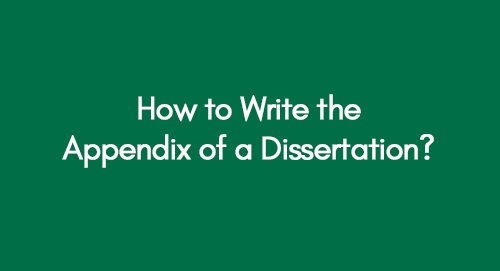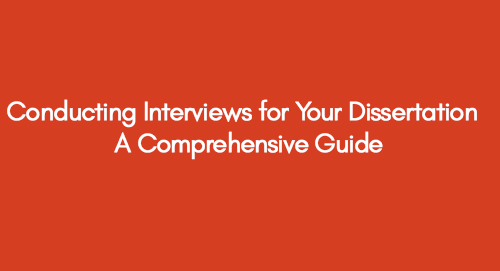
How Did Chanel Create a Brand Identity That Made It a Loveable UK Brand?
August 24, 2022
What is a Hypothesis in a Dissertation? Characteristics and Types
August 26, 2022An appendix is vital to a dissertation, showcasing your completed work. It should be crafted with the same care as other research sections. This guide provides precise instructions for proper preparation.
What is an Appendix in a Dissertation?
Appendices are sections in dissertations that contain nonstandard data. The goal is to improve the quality of work and make it more reliable and evident. You should use this section to show your readers how competent you are and how deep the topic is. A table, an image, a map, and documents related to your research are contained in this section.
These pages are usually found at the end of a dissertation. The volume of appendices is not considered when calculating the total work size. Without attachments, your main text should be 70 pages if your research requires 70 pages. Uncover the secrets to effectively incorporating appendices into your dissertation with our step-by-step guide on how to write the appendix of a dissertation.
Get 3+ Free Custom Topics within 24 hours;
Why is an Appendix Important for Research?
The role of an appendix in a paper must be understood before learning what it is. The most common appendix format is APA, but that is not always necessary. The format of appendices differs slightly from that of the body of the text.
Appendices in APA papers contain information that would not fit in the body of the essay, such as detailed or complex information. To avoid overwhelming the readers with information, that section was created. It helps you keep your essay focused on the topic instead of explaining everything.
Any large materials not included in the work text are placed in the appendix. All information provided here is for informational and reference purposes only. Consider a situation in which research conclusions are in disagreement. After that, you can clarify the situation with detailed data from the appendices.
Example: Several conclusions of the defense commission were questioned by members of the commission. Afterwards, you can illustrate how the application form is constructed and how the answers are analyzed. Due to their large volume, these documents do not make sense to include in work text. Nonetheless, this part is extremely helpful in proving that the process is correct.
- It is important to include appendices to dissertations as they provide more information on the topic.
- The words in a research paper are maintained by this method.
- It is important to provide background information about your topic or subject in the appendix section.
- Content flow is prevented from being disrupted by it.
- Research reports can be made clearer and more concise by including the appendix.
What is Included in an Appendix?
There are several kinds of supplementary information that can be added to an appendix in a dissertation:
Research Results
The results of the research can be presented in a number of ways, including tables and diagrams. The main body of your dissertation will not be able to include all your results, even though they are useful to some extent. It is, therefore, critical that only those facts are included to answer your research question.
The appendix should include raw data, proof of control measures, and other supplemental materials that are less significant.
Details of Questionnaires and Interviews
If you have conducted surveys or interviews, you can include their details. The following can be included:
- Transcripts of interviews,
- If there are any survey questions, a copy of them,
- Results of the questionnaire.
In the appendix of the dissertation, you can include the full form of your surveys, questionnaires, and interviews, even though their results should be presented and discussed in your main text.
Tables, Figures, and Illustrations
It may be helpful to include the less important tables, figures, and illustrative materials in your appendix if your dissertation contains a large number of them. It is possible to present data and trend lines (each identified by a different color) from four related datasets on a single chart and to provide further breakdowns for each dataset in the appendix.
Correspondence and Letters
This section should include any correspondence you have, whether it is between yourself and other researchers or the places where you sought permission to re-use copyrighted material. In this way, you can prevent plagiarism accusations against your dissertation.
List of Abbreviations
An appendix with abbreviations should be included in most dissertations; if not, it would be wise to include one at the beginning.
Your readers may not have the same background as you, so abbreviations and technical terms may be difficult to understand for them.
FYI: Researchers sometimes refer to this as a glossary, especially if it is included as an appendix. There is no difference between this and a list of abbreviations for all intents and purposes.
What is the Method of Formatting an Appendix?
There is no need to break up your appendix into different components if you prefer to have one long appendix in your dissertation.
However, you might consider separating questionnaire responses, findings, key phrases, and key terms into appendices to make it easier for your readers to understand the information.
You should include multiple appendices within your document, each with its own title and number, like "Appendix 7-Survey questions". By doing so, the reader and researcher can see every section of the appendix clearly.
For each element directly linked to an appendix in the main body, it is also recommended to include the number and title so that the reader knows what you are referring to.
Number each appendix separately, as well as tables and figures. Thus, the first table or figure in a new appendix would be called Table 1 or Figure 1.
Referring to the Appendix in the Main Body
Your dissertation's main body should include an indication of all appendices at least once. Be sure to indicate the appendix number within the text of the main body (called descriptive reference) to highlight it for readers.
Researchers are not required to capitalize it since that is up to their own discretion. A specific illustration or table can also be mentioned within the appendix (for example, a graph or table).
Example 1: Whenever you are talking about an entire appendix
Appendix 1 shows the results of the focus-group interview...
Detailed information about how the sample population was gathered can be found in Appendix 2.
Example 2: In the case of an appendix component
According to these findings (see Appendix 1, Table 2)...
There are several factors that lead to an increase in sales, as shown in Table 2 in Appendix 1.
When referring to an Appendix, using uppercase would be a good idea. Nevertheless, you may choose to use lower-case, for example, 'The appendices at the end of the document contain relevant information regarding the questionnaire responses.'
What is the Process of Writing an Appendix?
Below is the detailed process with useful tips to keep in mind:
Step 1: Collecting Data
Collect and include raw data in your paper's appendix to support findings and engage your reader effectively. Include relevant information discussed in your paper, sample calculations, specialized details, and cited factual data for enhanced clarity. Include graphs, charts, or images to support your argument.
As well as text, the appendix should include images, maps, drawings, diagrams, and graphs. Visuals should only be included in your paper if they are supporting your findings. If you create graphs or charts yourself or obtain them from another source, you may include them. If you include a visual that is not your own, be sure to cite it properly.
Document your research instruments in the appendix, like video cameras or tape recorders. Explaining their use in data collection aids reader understanding.
Example: If you want to record the interviews and surveys, you may include the following statement in the appendix: " Interviews and surveys were conducted privately and recorded."
Include interview and survey transcripts in your appendix, featuring questions and answers. Save hand-completed surveys or digital copies. Add relevant correspondence with subjects, like emails, letters, and notes.
Step 2: Formatting the Appendix
Give a title to the appendix. It is important to title the appendix at the top of the page clearly. You can use the same font and size for your chapter headings as you used in your paper or essay, for example, "Appendix." Use all capital letters, such as "APPENDIX," or sentence case, such as "Appendix."
Organize your appendices alphabetically or numerically if you have more than one. The appendices should be labeled "Appendix A," "Appendix B," etc., if you are using letters. You should title your appendices "Appendix 1," "Appendix 2," etc., if you are using numbers.
You should begin each appendix on a new page if you have more than one. By doing so, the reader will not be confused about where one appendix ends and another begins. The appendix should be arranged in a particular order. According to where the content appears in the text, you should order the content in the appendix. Making the appendix more user-friendly and accessible will make it more user-friendly.
The raw data in your appendix should be placed first if it is referred to in your paper's first line. The interview questions should appear at the end of your appendix if you mention them at the end of your paper.
List references before the appendix, per the professor's instructions. Include an appendix in the table of contents, numbering them consistently with your paper, typically starting from the last page of the main text (e.g., page 27). Maintain formatting consistency throughout.
Step 3: Clarify and Cohere the Appendix
Appendices do not have a standard number of pages or words, but they should not be long-winded. Ensure all the information in the appendix or appendices pertains to the text. If there is information that doesn't relate to the text or illuminates it in some way, remove it. Your paper may appear unprofessional and cluttered if you have an overly long appendix.
You may find it useful if you have a mentor or peer who can read the appendix. You should ask them if all the information included in the paper is relevant, and you should remove any information they feel is unnecessary.
Make sure that your work is error-free. Ensure there are no spelling, grammar, or punctuation errors in the appendix. Try to review the appendix on your own and use spell check on your computer. Be sure to read the appendix backward so that any spelling errors can be identified. Professionalism is important when it comes to the appendix.
If you note an appendix in your text, you might write: "I feel my research was conclusive (see Appendix A for interview notes)," or "My research produced the same results in both cases."
Where Do You Place Your Appendices?
In most cases, appendices are placed after the main body and after the references. Separate appendices can also be included with the paper as part of a separate document.
A Quick Checklist to Follow:
Even though glossaries can be included in appendices, they are not appendices. An appendix should contain all information that can be found in the main document.
- The material related to your research topic can be supplementary or indirectly related. The matter to be included in the appendix should be decided by you.
- It should be started on a new page.
- Divide the material into sections based on the type of material you used, such as graphs, charts, interviews, etc. Appendices should then be made and numbered appropriately with titles.
- The title and sub-title of each appendix should be included.
- You need to make sure that the section is clearly formatted and easy to trace since it will be referred to at least once in the main body.
What is the Difference Between Appendixes and Appendices?
Are you wondering whether to use appendixes or appendices? The two may seem to be correct to you. Is one more common than the other? We will explain it quickly!
Over the past few decades, American English has taken the following views:
"Appendixes" used to be regarded as a supplementary component of the body, incorrectly representing the plural of "Appendix." The accurate plural form is "Appendices."
Unfortunately, many people chose the wrong variant by mistake. So, with English being constantly evolving, it began to spread out quickly. In academic and public documents, this variant began to appear. As of today, both words are accepted as correct by modern dictionaries. In recent years, "appendices" have become more popular.
If you are interested in other publications in your field, we recommend you look them up. Take a look at the words they are using.
What are Some Tips for Writing an Appendix for a Dissertation?
Below are some to keep in mind when writing the perfect appendix:
-
Check Out a Few Examples
An appendix or several appendices are attached to every book, dissertation, research paper, or academic article. It would be helpful if you reviewed a few appendices before writing your own. It may be helpful to use examples to better understand the structure and format of an appendix and the components that might be included. It is easy to find many examples of this kind online.
-
When Referring to an Appendix
If you prepare an appendix, include a few notes referring to it in your dissertation's main body. One element or point at a time should be referred to. It is not enough to say, "Refer to the appendix at the end of this thesis." Instead, use something like 'Refer to Appendix 2, point 4, to learn more about table 2.3.
-
Divide Elements and Their Explanations into at Least Two Columns
An appendix should be prepared with a column for the words or phrases and a column for their explanations. Organizing your appendix this way would make it neat and tidy. To make the appendix systematic, each word should be accompanied by its explanation.
-
Make Sure the Tables and Graphs are Titled and Labeled
A title should be assigned to each table and graph, which clarifies their contents. Also, do the labels. The reader should also be able to understand what they mean by the labels. There must be a clear statement of their position in their dissertation.
-
Place These Appendices in the Correct Order
Making dissertation appendices aesthetically pleasing and proper requires proper order. Appendices should not be scattered all over the place. Appoint proper spacing between two appendices, and arrange them rationally. New pages should be added to each appendix.
-
Data Collection Dates and Times should Be Included
Data collection dates and times can be included in the appendices of your dissertation if they are not directly relevant to your findings or do not influence them. This way, you can provide your reader with the information he or she needs without overwhelming them.
FAQs about Dissertation Appendix
Get an Immediate Response
Discuss your custom requirements with our writers
Free Online Plagiarism Checker For Students
We will email you the report within 24 hours.
Upload your file for free plagiarism





























